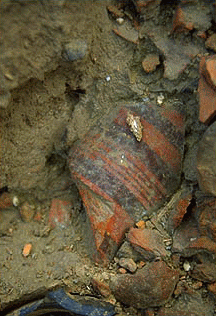

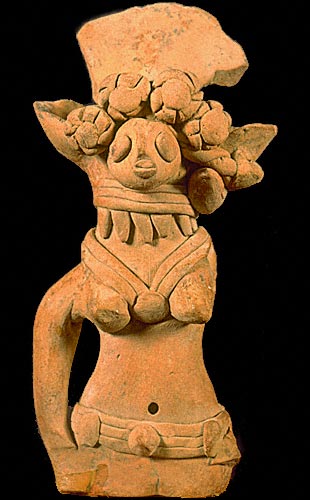
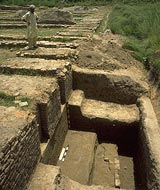

Harappa




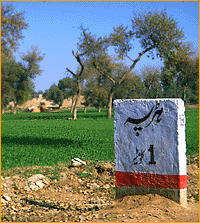 The
remains of famous Indus Valley Civilizations were first discovered in 1920-21 when
engraved seals were discovered near present-day Sahiwal in Pakistani Punjab at a
place called Harappa. It was from here that archaeologists in their quest to find
more remains finally bumped into the remains of Moenjodaro in Sind. In fact
the Harappan and indus valley civilizations extend to the Yamuna along the bed of the river Ghaggar in Rajhastan, Gujrat and upto
the mouths of the rivers Narbada and Tapati. Most of the the major sites of this
civilization are in Pakistan. The ruins of Harappa lie 35-km southwest of
Sahiwal (about 250 km from Lahore).
Situated besides an earlier course of the Ravi River, the remains of Harappa were ravaged by brick-hunters using the material as blast when the
railway tracks between Lahore and Multan were laid. However, several cemeteries,
which escaped the attention of vandals, have been excavated to reveal the
richness and sophistication of its culture. The Hrappan excavations reveal a series of cities, stacked one
upon another. The site, with its citadel and great granary, seems similar in
many ways to Moenjodaro and like its southern sister-city appear to have thrived
around 2000 to 1700 B.C. with an economy based largely on agriculture and trade.
The Harappan society seems to have been egalitarian, pursuing a rather simple
way of life. The cemeteries discovered at Harappa confirm that the Indus Valley
people buried their dead, many of them wearing finger rings, necklaces of
steatite beads, anklets of paste beads, earnings and shell bangles. Copper
mirrors, antimony rods, shell spoons and vessels and urns of various shapes and
size lay in the graves. Some of the female skeletons had anklets of tiny beads
and girdles studded with semi-precious stones.
The
remains of famous Indus Valley Civilizations were first discovered in 1920-21 when
engraved seals were discovered near present-day Sahiwal in Pakistani Punjab at a
place called Harappa. It was from here that archaeologists in their quest to find
more remains finally bumped into the remains of Moenjodaro in Sind. In fact
the Harappan and indus valley civilizations extend to the Yamuna along the bed of the river Ghaggar in Rajhastan, Gujrat and upto
the mouths of the rivers Narbada and Tapati. Most of the the major sites of this
civilization are in Pakistan. The ruins of Harappa lie 35-km southwest of
Sahiwal (about 250 km from Lahore).
Situated besides an earlier course of the Ravi River, the remains of Harappa were ravaged by brick-hunters using the material as blast when the
railway tracks between Lahore and Multan were laid. However, several cemeteries,
which escaped the attention of vandals, have been excavated to reveal the
richness and sophistication of its culture. The Hrappan excavations reveal a series of cities, stacked one
upon another. The site, with its citadel and great granary, seems similar in
many ways to Moenjodaro and like its southern sister-city appear to have thrived
around 2000 to 1700 B.C. with an economy based largely on agriculture and trade.
The Harappan society seems to have been egalitarian, pursuing a rather simple
way of life. The cemeteries discovered at Harappa confirm that the Indus Valley
people buried their dead, many of them wearing finger rings, necklaces of
steatite beads, anklets of paste beads, earnings and shell bangles. Copper
mirrors, antimony rods, shell spoons and vessels and urns of various shapes and
size lay in the graves. Some of the female skeletons had anklets of tiny beads
and girdles studded with semi-precious stones.
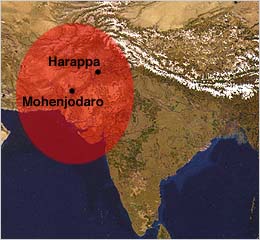
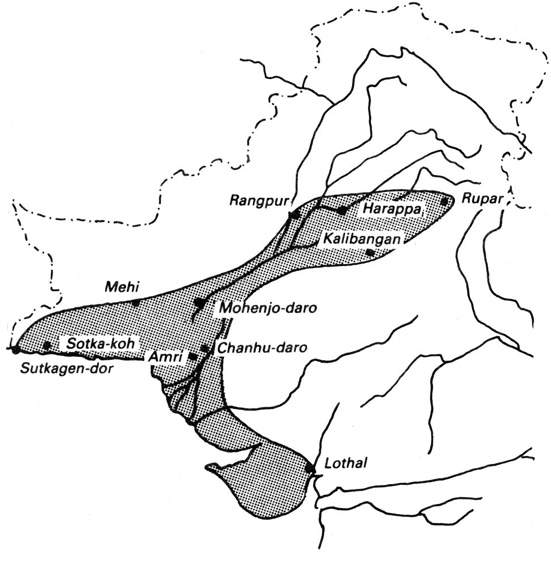
The excavations that began in the 1920s began on one of mounds near present day Sahiwal. The archaeologists did not imagine that a city lay beneath the earth and later also discovered another large city to the recovery of at least eighty villages and towns related to this newly discovered civilization. They named it Harappan after the first city they discovered, but it is more commonly called the Indus River civilization. While we have stones and tools and fragments and bones, we really have no one's voice or experience from the bustling days of the great Harappan cities. We don't know who the people were who built and lived there. We don't know, either, when they first built their cities; some scholars argue that Harappan civilization arises around 2250 BC, while others argue that it can be dated back to 2500 BC or earlier.
Like the civilizations in Mesopotamia, Egypt, and Greece, Harappa grew on the floodplains of a rich and life-giving river, the Indus. The original cities and many of the towns seemed to have been built right upon the shores of the river. The Indus, however, is destructive and unpredictable in its floods, and the cities were frequently levelled by the forces of nature. Mohenjo-Daro in the south, where the flooding can be fairly brutal, was rebuilt six times that we know about; Harappa in the north was rebuilt five times.
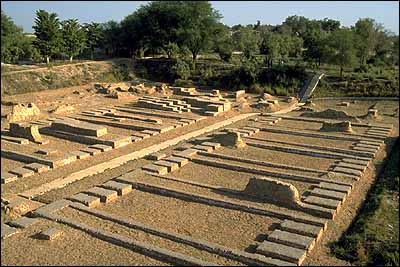
Grain Storage Granary
The people of Harappa had an economy almost entirely dominated by horticulture. Massive granaries were built at each city, and there most certainly was an elaborate bureaucracy to distribute this wealth of food. The Indus River valley is relatively dry now, but apparently it was quite wet when the Harappans thrived there. We know this because the bricks that they built their cities with were fired bricks; since sun-dried bricks are cheaper and easier to make, we can only assume that over-abundant humidity and precipitation prevented them from taking the cheaper way out. In addition, many of the Harappan seals have pictures of animals that imply a wet and marshy environment, such as rhinoceroses, elephants, and tigers. The Harappans also had a wide variety of domesticated animals: camels, cats, dogs, goats, sheep, and buffalo.
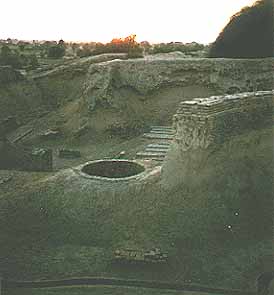
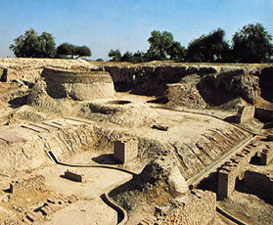
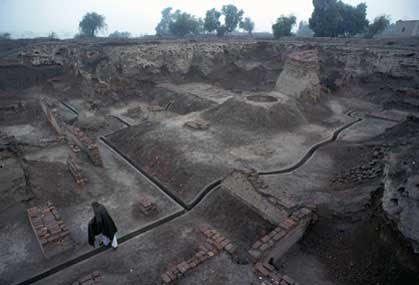
The remains at Harappa reveal carefully planned and laid out cities and Harappan are considered to be the first people to plan the building of their cities. Whenever they rebuilt their cities, they laid them out precisely in the same way the destroyed city had been built. The pathways within the city are laid out in a perpendicular criss-cross fashion; most of the city consisted of residences. A large public well and public bathing platforms were found in the southern part of Mound AB at Harappa. These public bathing areas may also have been used for washing clothes as is common in many traditional cities in Pakistan and India today.
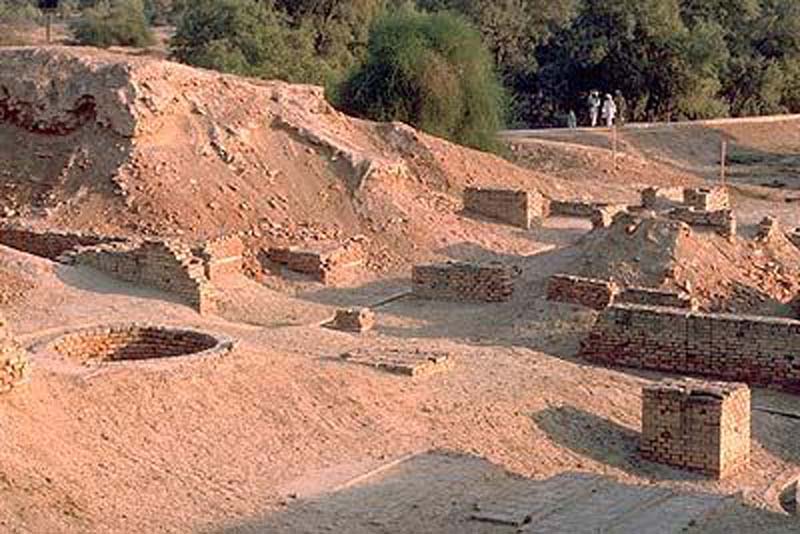
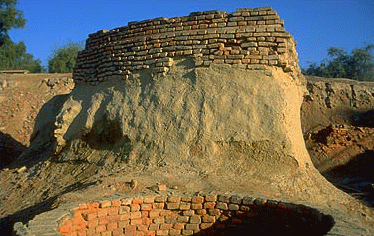
Public Well
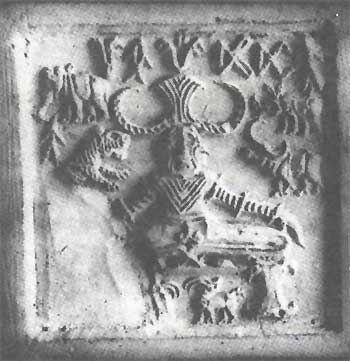
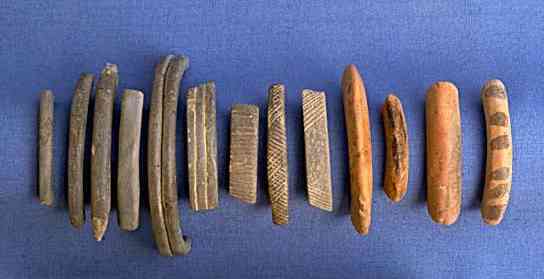
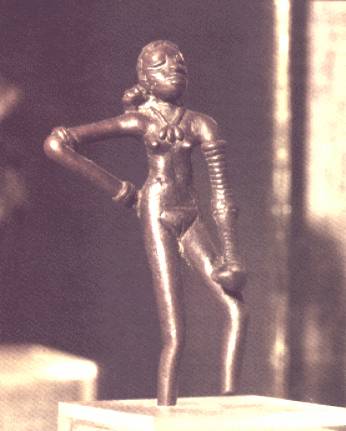
Nothing much is known about the religion of the Harappans. Unlike in Mesopotamia or Egypt, which abound in temples and altars, no such remains have been found at Harappa which could resemble a temple or involve any kind of public worship. However, a number of tantalizing figures on various seals and statues represent some sort of goddess worship. There is, however, some sort of male god (maybe) that has the head of a man with the horns of a bull. From the various artifacts found at the sites, it looks as if Harappans worshipped natural objects or animistic forces, but the circumstances of this worship can only be guessed at.
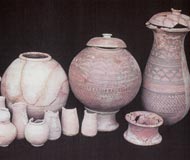
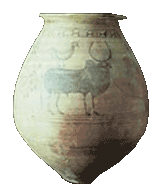
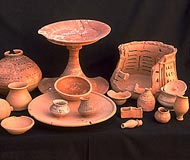
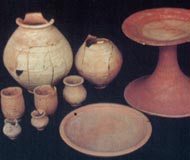
As for the language of Harappans, there are again guesses. Harappan writing resemble a pictographic script, or at least seems to be; as of yet, however, no one has figured out how to decipher it or even what language it might be rendering. The logical candidate is that the Harappans spoke a Dravidian language, but that conclusion, which may not be true, has not helped anybody decipher the script. Like the rest of Harappan civilization, the writing was lost to human memory after the disappearance of the Harappans.
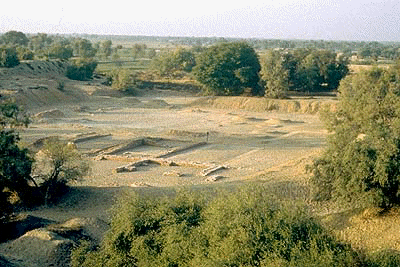
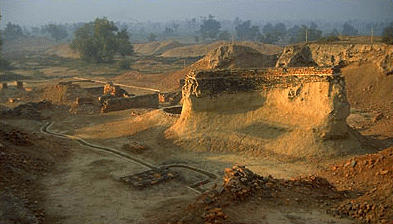
The Harappan civilization was mainly urban and mercantile. Inhabitants of the Indus valley traded with Mesopotamia, southern India, Afghanistan, and Persia for gold, silver, copper, and turquoise. The Mesopotamian model of irrigated agriculture was used to take advantage of the fertile grounds along the Indus River. Earth-links were built to control the river's annual flooding. Crops grown included wheat, barley, peas, melons, and sesame. This civilization was the first to cultivate cotton for the production of cloth. Several animals were domesticated including the elephant which was used for its ivory. Most of the artwork from Harappan civilization was small and used as personal possessions. The first objects unearthed from Harappa (and also Mohenjo-Daro) were small stone seals. These seals were inscribed with elegant portrayals of real and imagined animals and were marked with the Indus script writing. The seals suggest a symbolic or religious intent. Stone sculptures carved in steatite, limestone, or alabaster depict a male figure who may have represented a god. Pottery figures were shaped into humans and animals. Very few bronze figures have been recovered.
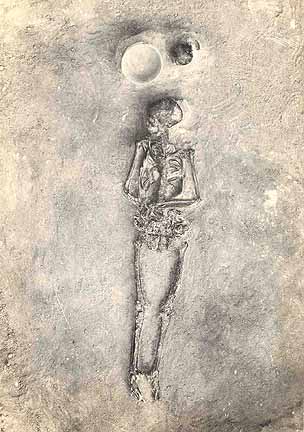 The Harappan civilization
experienced its height around 2500 BC and began to decline about 2000 BC. The
causes of its downfall , like that of Moenjodaro, are based on speculations and
theories since Harappans disappeared without leaving any trace. One theory
suggests that the Aryan people migrated into this area. Aryan religious texts
and human remains in Mohenjo-Daro suggest that the Aryans may have violently
entered the area, killing its inhabitants and burning the cities. Some believe
that the periodic and frequently destructive flooding of the Indus finally took
its toll on the economic health of the civilization. It is possible that the
periodic changes of course that the Indus undergoes also contributed to its
decline. It is widely believed that somewhere between 1800 and 1700 BC, the
Harappan cities and towns were abandoned and finally reclaimed by the rich soil
they had sprung from. A more recent evidence suggests that this civilization may
have begun to decline before the Aryans arrived. The inhabitants of the Indus
valley dispersed before the Aryans slowly entered the area as a nomadic people.
The Aryans were then able to take over this area since most of the inhabitants
had previously left. One cause of the dispersal of the Harappans could have been
a result of agricultural problems. Topsoil erosion, depletion of nutrients from
the soil, or a change in the course of the Indus River may have forced these
people to leave their towns and move north-eastward in search of more fertile
land.
The Harappan civilization
experienced its height around 2500 BC and began to decline about 2000 BC. The
causes of its downfall , like that of Moenjodaro, are based on speculations and
theories since Harappans disappeared without leaving any trace. One theory
suggests that the Aryan people migrated into this area. Aryan religious texts
and human remains in Mohenjo-Daro suggest that the Aryans may have violently
entered the area, killing its inhabitants and burning the cities. Some believe
that the periodic and frequently destructive flooding of the Indus finally took
its toll on the economic health of the civilization. It is possible that the
periodic changes of course that the Indus undergoes also contributed to its
decline. It is widely believed that somewhere between 1800 and 1700 BC, the
Harappan cities and towns were abandoned and finally reclaimed by the rich soil
they had sprung from. A more recent evidence suggests that this civilization may
have begun to decline before the Aryans arrived. The inhabitants of the Indus
valley dispersed before the Aryans slowly entered the area as a nomadic people.
The Aryans were then able to take over this area since most of the inhabitants
had previously left. One cause of the dispersal of the Harappans could have been
a result of agricultural problems. Topsoil erosion, depletion of nutrients from
the soil, or a change in the course of the Indus River may have forced these
people to leave their towns and move north-eastward in search of more fertile
land.
The similarities in plan and construction between Mohenjo-Daro and Harappa indicate that they were part of a unified government with extreme organization. Both cities were constructed of the same type and shape of bricks. The two cities may have existed simultaneously and their sizes suggest that they served as capitals of their provinces. In contrast to other civilizations, burials found from these cities are not magnificent; they are more simplistic and contain few material goods. This evidence suggests that this civilization did not have social classes. No hard evidence exists indicating military activity; it is likely that the Harappans were a peaceful civilization. The cities did contain fortifications and the people used copper and bronze knives, spears, and arrowheads.
Those who replaced the Harappans, as well as those in Moenjodaro, were most certainly supplanted by waves of migrations of Indo-Europeans. These new peoples, however, did not seem to adopt the religious practices of the Harappans, so it is not possible to reconstruct Harappan religion through the religion of the Vedic peoples, that is, the Indo-Europeans who constructed the rudimentary Indian religion represented by the Vedas.
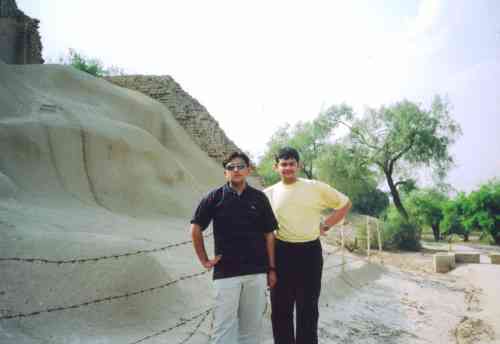
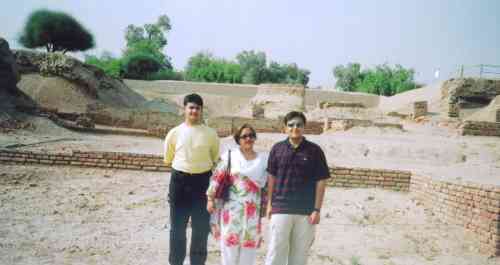
Tourists at Harappa
Harappa and Moenjodaro are two places which form the focal point of tourist attraction. So if you are in Pakistan do not miss these historical journeys. The displays in the local museums will most certainly unfold the entire history in a few hours.
Related Links:
| Excavations At Harappa:
My Perspective |
|
Walk Around Harappa
|Harappa
|
|
Pyrotechnological Craft Production - Harappa
| |Technology
and Material Culture |
Harappa - 3D |
|
| HOME PAGE | ARCHAEOLOGICAL TREASURE OF PAKISTAN |
This page was created on
6 October 2006
|